From - BBC World News
By -Deborah Nicholls-Lee
Edited by - Amal Udawatta
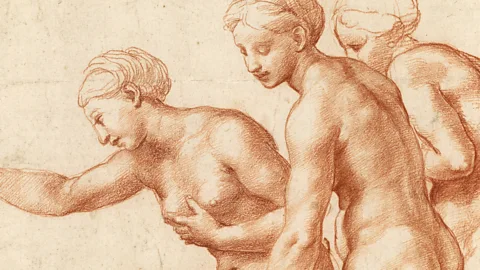 The Royal Collection Enterprises Limited 2024/ Royal Collection Trust
The Royal Collection Enterprises Limited 2024/ Royal Collection TrustHow a rarely-seen drawing of the Three Graces by Raphael reveals the era's ideas about nudity, modesty, shame – and the artist's genius. It's part of an exhibition, Drawing the Italian Renaissance – at The King's Gallery, Buckingham Palace – of drawings from 1450 to 1600, the biggest of its kind ever shown in the UK.
A wandering lobster and a sturdy ostrich feature among the 150 chalk, metalpoint and ink drawings on show at Drawing The Italian Renaissance, at the King's Gallery, Buckingham Palace. Created by Renaissance giants such as Leonardo da Vinci, Michelangelo, Raphael and Titian, often in preparation for larger painted tableaux, the works are thought to have entered the Royal Collection in the 17th Century under Charles II, several as gifts. For more than 30 of them, it's their first time ever on public display. Rarely shown due to their fragility, these fascinating drawings – which, at the time, were beginning to be recognised as artworks in their own right – make up the broadest exhibition of Italian drawings from 1450 to 1600 ever shown in the UK.
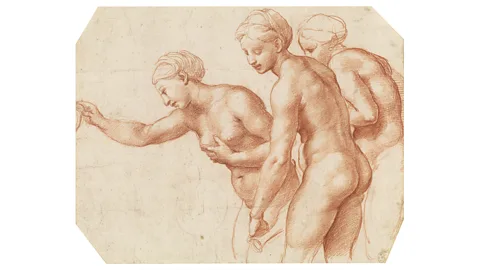 The Royal Collection Enterprises Limited 2024/ Royal Collection Trust
The Royal Collection Enterprises Limited 2024/ Royal Collection TrustRarer still than these animal studies are the drawings of female nudes, outnumbered by a factor of three by an abundance of naked men. "The male body is this absolute focus of creativity," explained Renaissance historian Maya Corry, discussing the exhibition on BBC Radio 4's Front Row in October. "This is a Christian society and it's the male body, not the female body, that's made in God's image." Leonardo Da Vinci's Vitruvian Man, with his ideal body proportions, is a case in point. It is the male physique, she said, that "comes closest to divine perfection" in those times.
There were practical issues, too. "The artist's workshop would have been a male environment, and in the absence of 'professional models' it would have gone against all societal norms for a woman to undress in front of any man other than her husband," Martin Clayton, the exhibition's curator, tells the BBC. It was male models who would pose for Michelangelo, for example, when he needed a female figure. "This led to misunderstandings and distortions in depictions of the female body."
Raphael, however, was among the first to buck the trend, sketching female nudes based on real life models. "He was a highly pragmatic artist, who used drawing brilliantly to tackle visual problems, and to work very quickly from first idea to final composition," says Clayton. The drawings "allow us to see the artist's immediate responses to the living figure as they investigated pose, proportion, movement and anatomical detail," he adds. In the case of Raphael, "his simultaneous decisiveness and openness to variations and possibilities is always on display."
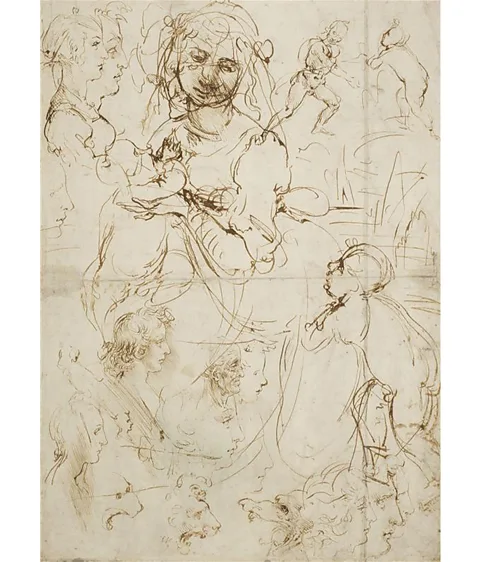 The Royal Collection Enterprises Limited 2024/ Royal Collection Trust
The Royal Collection Enterprises Limited 2024/ Royal Collection TrustRaphael’s The Three Graces (c1517-18), a work in red chalk with evidence of some metalpoint underdrawing, reveals the artist's genius at work. As he moves a single model through three different poses, we witness the meticulous process behind creating the exuberant fresco The Wedding Feast of Cupid and Psyche, where these three figures will eventually feature, anointing the newlyweds to confer their future happiness. Unclothed, the complexity of the human body was the ultimate test of a Renaissance artist's talent, while also satisfying the era's passion for science. The women's shapely biceps and quadriceps speak to the same interest in anatomy that we see in Da Vinci's densely annotated The Muscles of the Leg (c1510-11), also on display. But there's a softness about the face and abdomen that is missing from the exhibition's depictions of men, such as The Head of a Youth (c1590) with its angular jaw, attributed to Pietro Faccini, or Bartolomeo Passarotti's sinewy St Jerome (c1580).
The feminine ideal
Much like Michelangelo's David, sculpted a decade earlier, Raphael appears to chase an ideal – even when drawing from life. In a letter reportedly written to his friend Baldassare Castiglione in 1514, he expresses the struggle of capturing perfection in real life. "To paint one beautiful woman I would have to see several beauties," he writes. "But since both good judgement and beautiful women are scarce, I make use of a certain idea that comes to mind."
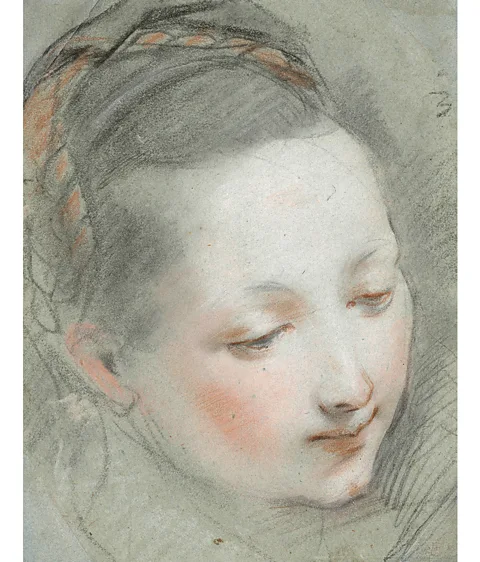 The Royal Collection Enterprises Limited 2024/ Royal Collection Trust
The Royal Collection Enterprises Limited 2024/ Royal Collection TrustIn Raphael's The Three Graces, "beauty" means hairless, unblemished skin, and breasts and buttocks as perfectly round as the apples the trio clutch in his c1504-1505 treatment of the myth. When Sandro Botticelli made the Graces a feature of his vast tableau Spring, feminine softness was emphasised by flowing hair and diaphanous fabrics, while Pietro Liberi's post-Renaissance rendition of the subject (c1670-80) features the rosy cheeks and marble flesh that we see in works such as Federico Barocci's The Head of the Virgin (c1582), painted a century earlier, and also on display at the King's Gallery.
The rarity of female painters and patrons in the Renaissance meant that artworks inevitably reflected the male gaze. "Perceptions of gender and women's subordinate role in Renaissance culture played out in images, and especially portraits, with images of men stressing their social, political or professional role and status – the masculine ideal being very much one of forceful mastery," says historian and author Julia Biggs, an expert in Renaissance art history. "By contrast, the women encountered in portraits from this time are portrayed primarily in relation to the traits of ideal (youthful) feminine beauty, virtuousness (modesty, humility, obedience) and motherhood."
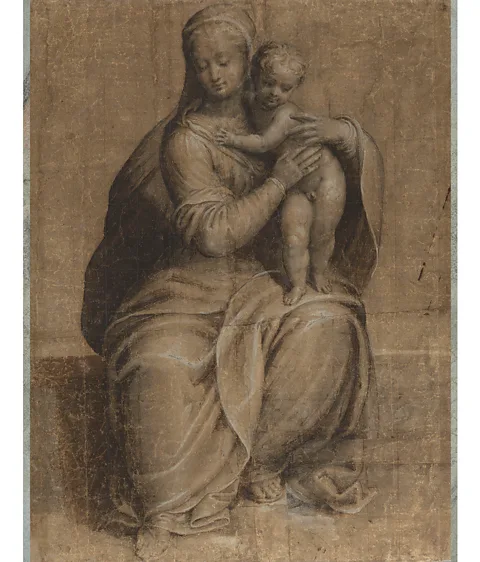 The Royal Collection Enterprises Limited 2024/ Royal Collection Trust
The Royal Collection Enterprises Limited 2024/ Royal Collection TrustAs deifications of charm, elegance and beauty, the Graces (Euphrosyne, Aglaea and Thalia), daughters of the Greek God Zeus, reflect a male view in their Renaissance depictions, not just of what a woman should look like, but also of how she should behave. They embody this nebulous concept of grace – closely associated with Raphael – which patrons were keen to attach to their image. It was a term that was bound up with distinction, benevolence and love, while the Graces' circular dance suggests balance and harmony − key principles of the Renaissance aesthetic. As a group, they combine a patriarchal lesson on feminine virtue with, unwittingly perhaps, a celebration of the female form and the sisterhood of female bonding.
More like this:
• These five bizarre artworks are not what they seem
At the time, female nudity had different connotations. On the one hand, Biggs tells the BBC, the Three Graces "may have formed part of the trope of 'virtuous nudity', where nakedness was "an indication of truthfulness and purity". Elsewhere, however, female nudity was "associated with shame". In Masacchio's fresco Expulsion from the Garden of Eden (c1424-27), only Eve, branded sinful, covers her genitals, while Biggs notes that "as part of the la scopa – the ritual humiliation of adulterous women in Ferrara, Italy – women were made to run naked through the city".
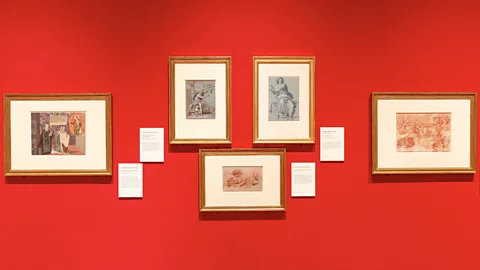 The Royal Collection Enterprises Limited 2024/ Royal Collection Trust
The Royal Collection Enterprises Limited 2024/ Royal Collection TrustSuch female nudity contrasted sharply with the modest female dress code of Renaissance Italy. "In public, the majority of women would cover their bodies from just underneath the collarbone down to their ankles, and cover their arms," Biggs explains. Mythological and Biblical scenes gave artists a pretext to disrobe them, and also answered, says Biggs, the desire of male patrons to display "erotic erudition" or perhaps even "pay tribute to their own sexual prowess". Even when the women are dressed, Drawing the Italian Renaissance reflects the dichotomous roles available to them, from a seductress in Annibale Carracci's The Temptation of St Anthony (c1595) to13 different Virgin Marys by Michelangelo, Da Vinci and their contemporaries. Yet, the exhibition suggests that we do more than simply stand back and drink in the Renaissance in all its flourishes and flaws. In place of the conventional catalogue is an illustrated sketchbook, and drawing materials are found in the galleries. We are invited to engage with the works through our own creative endeavour – for some an opportunity, perhaps, to redraw their definition of male and female.
Comments
Post a Comment